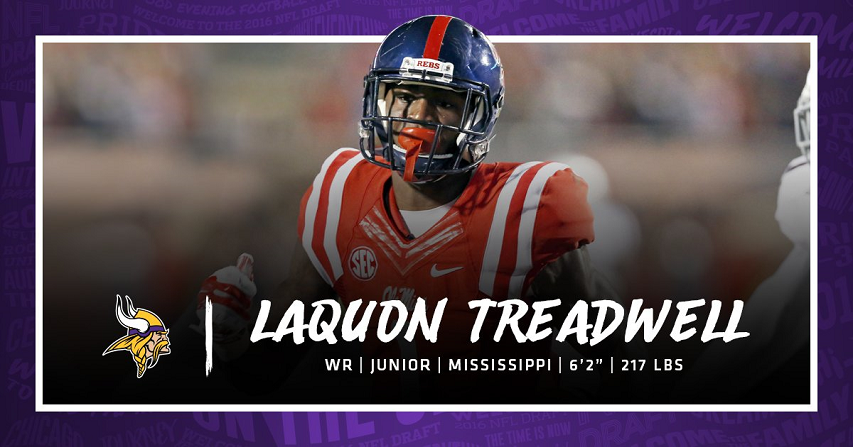 At the start of the first round of the draft, the Minnesota Vikings held the #23 pick. Given how frequently the team has depended on the wheeling-and-dealing skills of general manager “Trader Rick” Spielman, few of us were anticipating that the team would actually use that pick (although the Vikings actually did use their original first round pick in 2015).
At the start of the first round of the draft, the Minnesota Vikings held the #23 pick. Given how frequently the team has depended on the wheeling-and-dealing skills of general manager “Trader Rick” Spielman, few of us were anticipating that the team would actually use that pick (although the Vikings actually did use their original first round pick in 2015).

The most frequently mentioned wide receiver to be drafted by the Vikings was Josh Doctson, but he went to the Washington Redskins just ahead of Minnesota’s pick, so Laquon Treadwell ended up being the team’s first round pick at the #23 slot. Before the draft began, ESPN’s Ben Goessling had bucked the trend by selecting Treadwell in the NFL Nation mock draft, saying:
The Vikings brought both Treadwell and Doctson to their top 30 event earlier this month, and either one would fit a need for a big receiver on the roster. Either could be a viable option for the Vikings on Thursday night. But I leaned toward Treadwell for a couple of reasons.
First, while the Ole Miss receiver has slipped in mock drafts after his slow 40 time (4.63 seconds at his pro day), he still brings much of what the Vikings need for their offense. At 6-foot-2 and 221 pounds, he has plenty of size to deal with press coverage, and he has shown an ability to both be physical with cornerbacks and separate from them with his footwork. His size and mentality also should help him as a run blocker — no small part of playing wide receiver in the Vikings’ offense — and he has displayed an impressive understanding of positioning while competing against cornerbacks in the SEC.
Doctson is the better deep threat, and he’ll do a better job of plucking balls over the top of defensive backs. But Teddy Bridgewater might benefit more from a receiver who can box out defenders and present a reliable target in the red zone.
It’s also worth noting that Treadwell doesn’t turn 21 until June, while Doctson will be 24 in December. They typically haven’t taken players as old as Doctson in the first round; in fact, he’d be the Vikings’ oldest first-round selection since Todd Steussie in 1994. That doesn’t rule him out, but especially when the Vikings are looking for a receiver who can grow with their 23-year-old quarterback, it shouldn’t be discounted.
As I said yesterday, I don’t follow college football, so what little I know (or think I know) about the players in the draft is filtered through the coverage in fan blogs and the Minnesota media. Based on that, I’d have been happy with either Doctson or Treadwell, and from the information posted after the pick was made, I’m thinking Treadwell may well be a better fit in Minnesota than Doctson.
Teddy was the consensus #1 QB, then slid to the Vikings.
Treadwell was the consensus #1 WR, then slid to the Vikings.
I like this pattern.
— Eric Thompson (@eric_j_thompson) April 29, 2016
Of course, every player has both strengths and weaknesses, and Pro Football Focus rated the pick as only worth a “C+” grade:
Receivers are flying off the board as the Vikings add a physical outside presence in Treadwell. He’s a solid late-round pick (+19.8 receiving grade ranked 13th in the draft class), capable of winning in the short game (slants) and adding a red-zone presence with his size. The problem with Treadwell is creating separation at the intermediate and deep level, right where offensive coordinator Norv Turner is trying to get the ball. In addition to not separating well, his pairing with QB Teddy Bridgewater is not ideal as Bridgewater is hesitant to throw into tight windows and that marriage may not play to Treadwell’s skillset.
Even when playing in the contested game, Treadwell is not as exceptional as scouting reports may indicate. Overall, he’s a solid possession receiver, but the pairing with the Vikings and Bridgewater may not be a good one unless the offense turns to a more quick-hitting passing game that takes advantage of both Bridgewater and Treadwell’s skillsets.
PFF‘s Sam Monson believes Treadwell isn’t a good pick:
There is a lot to like about Treadwell, but he does struggle to separate, even in college. He has the movement skills of a big receiver, but at his size he’s not large enough that it should be preventing him getting open regularly. Often getting separation looks like a struggle and there are too many plays where he doesn’t just struggle to separate, but actively fails in his route to the defensive back.
[…]
Treadwell consistently separates far less than most of the receivers in this class. Watching his tape shows a player that relies more on his physicality than getting open in the first place, which is fine for a receiver in college that is already a team’s go-to guy, but in the NFL may result in the ball simply not being thrown his way nearly as often.
There are receivers in the NFL that can succeed despite not being able to consistently separate, but they are rare, and the majority of those that can’t simply don’t become high quality players at the position.
The last issue I have with Treadwell is that for all his ability to win jump balls and take the football away from defensive backs, he doesn’t actually go for them all that often. He allows passes to come to him at times where he should attack the ball and make sure of the catch, rather than wait on it and allow the defender back into the play.



